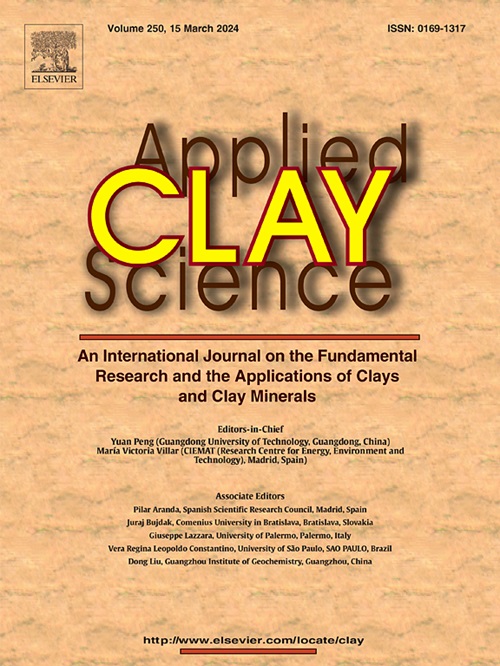十六烷基三甲基溴化铵改性蒙脱石-羟基磷灰石复合吸附剂对水溶液中铀(VI)的吸附行为
IF 5.3
2区 地球科学
Q2 CHEMISTRY, PHYSICAL
引用次数: 0
摘要
在这项任务中,通过使用十六烷基三甲基溴化铵(CTAB)进行表面活性剂改性并与羟基磷灰石(HAP)复合,成功制备了一种新型蒙脱石复合材料(CMH)。在 pH = 5.0 和 T = 298 K 条件下,初始 U(VI)浓度为 10 mg/L,在较宽的吸附剂剂量范围(0.2 至 1.0 mg/L)内,CMH 与自然蒙脱石(MMT)相比表现出更好的 U(VI)吸附性能(R > 99 %)。CMH对U(VI)的吸附容量达到678.6 mg/g,远高于大多数已报道的粘土类吸附剂,表明CMH的吸附性能在粘土类吸附剂中处于中上水平。此外,CMH 还具有良好的可回收性,5 次循环后的吸附效率为 96.2%,即使在复杂的水体系中仍能保持较高的六价铬吸附能力,有望用于吸附各种水环境中的六价铬。从 MMT 和 CMH 在形态、结构和组成上的差异来看,CMH 具有优异的 U(VI)吸附性能,原因在于其表面更粗糙、层间距更大、孔隙和官能团更多,从而提供了更多的结合位点。吸附机理包括静电作用、离子交换和络合作用。这项工作为探索低成本、高效吸附剂的合成提供了新的思路。本文章由计算机程序翻译,如有差异,请以英文原文为准。
Adsorption behaviors of U(VI) in aqueous solution by cetyltrimethylammonium bromide modified montmorillonite-hydroxyapatite composite adsorbent
In this task, a novel montmorillonite composite (CMH) was successfully prepared by surfactant modifying with cetyltrimethylammonium bromide (CTAB) and compounding with hydroxyapatite (HAP). In contrast to nature montmorillonite (MMT), CMH showed better U(VI) adsorption properties (R > 99 %) in a wide adsorbent dose range (0.2 to 1.0 mg/L) with the initial U(VI) concentration of 10 mg/L at pH = 5.0 and T = 298 K. The adsorption capacity of CMH for U(VI) reached 678.6 mg/g, which was much higher than most of reported clay-based adsorbents, suggesting that the adsorption performances of CMH were at the upper-middle level among clay-based adsorbents. In addition, CMH also performed good recoverability with the adsorption efficiency of 96.2 % after five cycles and could still maintain relatively high U(VI) adsorption capacity even during complex water system, which was expected to be used for adsorbing U(VI) from various water environment. In terms of the differences in morphology, structure and composition between MMT and CMH, the excellent U(VI) adsorption performances of CMH could be explained by the rougher surface, larger interlayer spacing and more pores and functional groups, thus providing more binding sites. The adsorption mechanism involved electrostatic interaction, ion exchange and complexation. This job supplied a novel opinion for the explore of low cost and highly efficient adsorbent synthesis for U(VI) adsorption.
求助全文
通过发布文献求助,成功后即可免费获取论文全文。
去求助
来源期刊

Applied Clay Science
地学-矿物学
CiteScore
10.30
自引率
10.70%
发文量
289
审稿时长
39 days
期刊介绍:
Applied Clay Science aims to be an international journal attracting high quality scientific papers on clays and clay minerals, including research papers, reviews, and technical notes. The journal covers typical subjects of Fundamental and Applied Clay Science such as:
• Synthesis and purification
• Structural, crystallographic and mineralogical properties of clays and clay minerals
• Thermal properties of clays and clay minerals
• Physico-chemical properties including i) surface and interface properties; ii) thermodynamic properties; iii) mechanical properties
• Interaction with water, with polar and apolar molecules
• Colloidal properties and rheology
• Adsorption, Intercalation, Ionic exchange
• Genesis and deposits of clay minerals
• Geology and geochemistry of clays
• Modification of clays and clay minerals properties by thermal and physical treatments
• Modification by chemical treatments with organic and inorganic molecules(organoclays, pillared clays)
• Modification by biological microorganisms. etc...
 求助内容:
求助内容: 应助结果提醒方式:
应助结果提醒方式:


